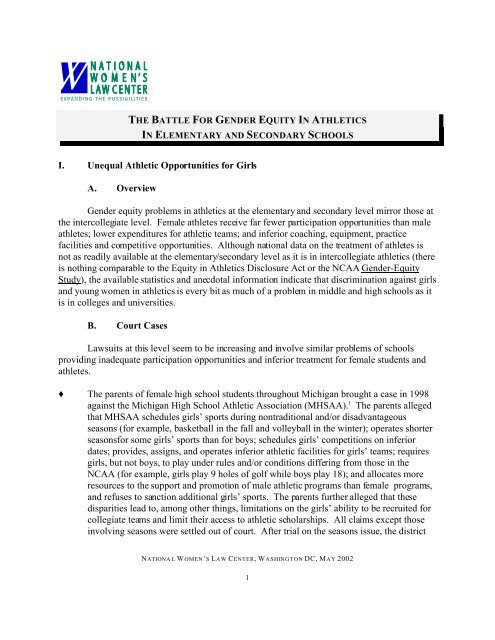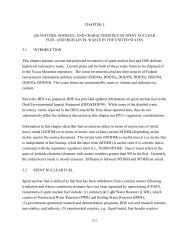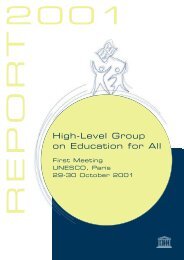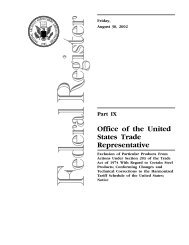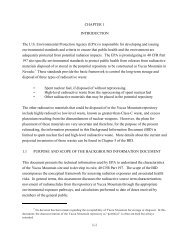The Battle for Gender Equity in Athletics in Elementary and
The Battle for Gender Equity in Athletics in Elementary and
The Battle for Gender Equity in Athletics in Elementary and
Create successful ePaper yourself
Turn your PDF publications into a flip-book with our unique Google optimized e-Paper software.
THE BATTLE FOR GENDER EQUITY IN ATHLETICSIN ELEMENTARY AND SECONDARY SCHOOLSI. Unequal Athletic Opportunities <strong>for</strong> GirlsA. Overview<strong>Gender</strong> equity problems <strong>in</strong> athletics at the elementary <strong>and</strong> secondary level mirror those atthe <strong>in</strong>tercollegiate level. Female athletes receive far fewer participation opportunities than maleathletes; lower expenditures <strong>for</strong> athletic teams; <strong>and</strong> <strong>in</strong>ferior coach<strong>in</strong>g, equipment, practicefacilities <strong>and</strong> competitive opportunities. Although national data on the treatment of athletes isnot as readily available at the elementary/secondary level as it is <strong>in</strong> <strong>in</strong>tercollegiate athletics (thereis noth<strong>in</strong>g comparable to the <strong>Equity</strong> <strong>in</strong> <strong>Athletics</strong> Disclosure Act or the NCAA <strong>Gender</strong>-<strong>Equity</strong>Study), the available statistics <strong>and</strong> anecdotal <strong>in</strong><strong>for</strong>mation <strong>in</strong>dicate that discrim<strong>in</strong>ation aga<strong>in</strong>st girls<strong>and</strong> young women <strong>in</strong> athletics is every bit as much of a problem <strong>in</strong> middle <strong>and</strong> high schools as itis <strong>in</strong> colleges <strong>and</strong> universities.B. Court CasesLawsuits at this level seem to be <strong>in</strong>creas<strong>in</strong>g <strong>and</strong> <strong>in</strong>volve similar problems of schoolsprovid<strong>in</strong>g <strong>in</strong>adequate participation opportunities <strong>and</strong> <strong>in</strong>ferior treatment <strong>for</strong> female students <strong>and</strong>athletes. <strong>The</strong> parents of female high school students throughout Michigan brought a case <strong>in</strong> 1998aga<strong>in</strong>st the Michigan High School Athletic Association (MHSAA). 1 <strong>The</strong> parents allegedthat MHSAA schedules girls’ sports dur<strong>in</strong>g nontraditional <strong>and</strong>/or disadvantageousseasons (<strong>for</strong> example, basketball <strong>in</strong> the fall <strong>and</strong> volleyball <strong>in</strong> the w<strong>in</strong>ter); operates shorterseasons<strong>for</strong> some girls’ sports than <strong>for</strong> boys; schedules girls’ competitions on <strong>in</strong>feriordates; provides, assigns, <strong>and</strong> operates <strong>in</strong>ferior athletic facilities <strong>for</strong> girls’ teams; requiresgirls, but not boys, to play under rules <strong>and</strong>/or conditions differ<strong>in</strong>g from those <strong>in</strong> theNCAA (<strong>for</strong> example, girls play 9 holes of golf while boys play 18); <strong>and</strong> allocates moreresources to the support <strong>and</strong> promotion of male athletic programs than female programs,<strong>and</strong> refuses to sanction additional girls’ sports. <strong>The</strong> parents further alleged that thesedisparities lead to, among other th<strong>in</strong>gs, limitations on the girls’ ability to be recruited <strong>for</strong>collegiate teams <strong>and</strong> limit their access to athletic scholarships. All claims except those<strong>in</strong>volv<strong>in</strong>g seasons were settled out of court. After trial on the seasons issue, the districtNATIONA L WOMEN’S LAW CENTER, WASHINGTON DC, MAY 20021
court judge held that the athletic association discrim<strong>in</strong>ated aga<strong>in</strong>st girls by schedul<strong>in</strong>g sixof their sports, but no boys’ sports, <strong>in</strong> nontraditional <strong>and</strong>/or disadvantageous seasons.<strong>The</strong> Court ordered the association to develop a plan by May 24, 2002 detail<strong>in</strong>g a newschedule <strong>for</strong> sports seasons that complies with the applicable laws. 2A case filed <strong>in</strong> 1997 aga<strong>in</strong>st a Florida school district challenged the unequal treatment ofboys’ <strong>and</strong> girls’ sports, specifically highlight<strong>in</strong>g differences <strong>in</strong> the treatment of thebaseball <strong>and</strong> softball teams. 3 <strong>The</strong> district court found that “[t]he [d]efendant has chosento favor the boys’ baseball team with a lighted play<strong>in</strong>g field, a scoreboard, a batt<strong>in</strong>g cage,superior bleachers, signs publiciz<strong>in</strong>g the team, bathroom facilities, <strong>and</strong> a concessionst<strong>and</strong>/press box/announcer’s booth, but has not seen fit to provide the girls softball teamwith any of these th<strong>in</strong>gs.” 4 <strong>The</strong> court went on to address the school district’s claim thatbecause the district funded the teams equally, but the teams’ booster clubs raised unequalsums of money, there was no Title IX violation. “<strong>The</strong> [c]ourt rejects this argument. It isthe [d]efendant’s responsibility to ensure equal athletic opportunities, <strong>in</strong> accordance withTitle IX. This fund<strong>in</strong>g system is one to which [d]efendant has acquiesced; [d]efendant isresponsible <strong>for</strong> the consequences of that approach.” 5 <strong>The</strong> school district was required tosubmit to the court a plan <strong>for</strong> remedy<strong>in</strong>g these disparities. 6In 1995, four cases were brought <strong>in</strong> Nebraska by female high school students aga<strong>in</strong>st fourseparate school districts. <strong>The</strong> pla<strong>in</strong>tiffs alleged unequal treatment of female athletes <strong>and</strong>failure to provide sufficient opportunities <strong>for</strong> female students to participate. All fourschool districts refused to sponsor varsity <strong>in</strong>terscholastic softball, despite the active<strong>in</strong>volvement of significant numbers of girls on privately-funded club softball teams <strong>in</strong>their communities. Settlement agreements were reached <strong>in</strong> each of the four cases. Inthese settlements, the school districts agreed to sponsor varsity softball <strong>and</strong> provide equaltreatment <strong>and</strong> benefits to female varsity athletes <strong>in</strong> all aspects of the athletic program,<strong>in</strong>clud<strong>in</strong>g schedul<strong>in</strong>g, locker rooms, facilities <strong>and</strong> coach<strong>in</strong>g. Another case <strong>in</strong>volv<strong>in</strong>g unequal athletic opportunities <strong>in</strong> high schools is Horner v.Kentucky, <strong>in</strong> which twelve female athletes who played <strong>in</strong>terscholastic slow-pitch softballsued the Kentucky State Board of Education <strong>and</strong> the Kentucky High School AthleticAssociation <strong>for</strong> fail<strong>in</strong>g to accommodate the <strong>in</strong>terests <strong>and</strong> abilities of girls <strong>in</strong> Kentucky toplay high school sports. 7 Kentucky sanctioned fewer sports <strong>for</strong> girls than <strong>for</strong> boys <strong>and</strong>refused to sanction fast-pitch softball. Under KHSAA rules, Kentucky would not“sanction” a sport -- that is, recognize <strong>and</strong> sponsor a state tournament <strong>in</strong> that sport --unless at least 25% of member schools <strong>in</strong>dicate a will<strong>in</strong>gness to participate <strong>in</strong> that sport.<strong>The</strong> pla<strong>in</strong>tiffs wanted to play fast-pitch rather than slow-pitch softball because only the<strong>for</strong>mer is sanctioned by the NCAA, <strong>and</strong> there<strong>for</strong>e only fast-pitch softball players cancompete <strong>for</strong> college athletic scholarships. In a December 1994 op<strong>in</strong>ion, the Sixth Circuitupheld the pla<strong>in</strong>tiffs’ claim that Kentucky high schools failed to equally accommodate the<strong>in</strong>terests <strong>and</strong> abilities of female athletes, <strong>and</strong> reversed the district court’s dismissal of theNATIONA L WOMEN’S LAW CENTER, WASHINGTON DC, MAY 20022
case.In the mid-1980's, female high school students sued the Montana High SchoolAssociation (the body that regulates <strong>in</strong>terscholastic athletics <strong>in</strong> high schools) <strong>for</strong> sexdiscrim<strong>in</strong>ation <strong>in</strong> its athletic programs. 8 At that time, Montana’s high schools had seriousdisparities <strong>in</strong> athletic opportunities, expenditures, treatment <strong>and</strong> participation rates <strong>for</strong>boys <strong>and</strong> girls. A court-appo<strong>in</strong>ted facilitator found that opportunities <strong>for</strong> female highschool athletes <strong>in</strong> Montana were “grossly restricted compared to those same opportunities<strong>for</strong> boys.” In the parties’ settlement agreement, the Association pledged to advanceathletic opportunities <strong>for</strong> girls statewide by sett<strong>in</strong>g m<strong>in</strong>imum requirements <strong>for</strong> programs<strong>and</strong> establish<strong>in</strong>g compliance measures. <strong>The</strong> requirements <strong>in</strong>cluded sanction<strong>in</strong>g the samenumber of sports <strong>for</strong> both sexes, provid<strong>in</strong>g athletic seasons that assured cont<strong>in</strong>uity <strong>and</strong>opportunity, schedul<strong>in</strong>g tournaments at comparable locations, equaliz<strong>in</strong>g publicity, <strong>and</strong>assur<strong>in</strong>g equal opportunity <strong>in</strong> the selection of coaches <strong>and</strong> officials.C. Data• Female athletes currently make up almost 42% of high school athletes. 9 In 1972, fewerthan 295,000 girls competed <strong>in</strong> high school sports, a mere 7.4%, compared to 3.67million boys. 10 By the 2000-2001 school year, the number of girls had swelled to 2.78million while the number of boys <strong>in</strong>creased to 3.92 million. Today, the number of girlsenter<strong>in</strong>g high school sports is nearly double that of boys: there were 108,280 new femalehigh school athletes <strong>in</strong> 2000-2001 versus 59,320 new male athletes. 11• A 1994 survey done by the National Federation of State High School Associations foundthat a typical high school offers eight girls’ sports with 15 teams <strong>and</strong> ten boys’ sports with18 teams. 12 <strong>The</strong> Federation does not have data on disparities <strong>in</strong> expenditures or treatment<strong>and</strong> believes that such national data does not exist. However, anecdotal evidencesuggests that substantial disparities persist.• Reporters <strong>in</strong> a number of states have revealed disparities <strong>in</strong> schools’ treatment of girls <strong>and</strong>boys <strong>in</strong> high school athletics programs:Georgia – After a series of newspaper articles expos<strong>in</strong>g gender <strong>in</strong>equities acrossthe state, the Governor of Georgia signed legislation requir<strong>in</strong>g public schools tosubmit <strong>in</strong><strong>for</strong>mation on the treatment of male <strong>and</strong> female athletes. An Atlantapaper found that 64% of boys play competitive sports, <strong>and</strong> 36% of girls playcompetitive sports. Moreover, 86% of the legislative grants made <strong>for</strong> stadiums,light<strong>in</strong>g <strong>and</strong> equipment were directed to projects where the primary beneficiarieswere boys’ sports. Booster clubs also contributed to gender <strong>in</strong>equities. <strong>The</strong>state’s top school official says she th<strong>in</strong>ks that a case could be make that nearlyevery public high school <strong>in</strong> the state might be <strong>in</strong> violation of Title IX. 13NATIONA L WOMEN’S LAW CENTER, WASHINGTON DC, MAY 20023
Louisiana – Local reports abound about the small number of sanctioned sports<strong>for</strong> girls <strong>and</strong> the <strong>in</strong>equitable facilities, equipment, <strong>and</strong> budgets <strong>for</strong> <strong>and</strong> thetreatment of, female student athletes <strong>in</strong> the New Orleans metro area. Stories<strong>in</strong>clude: boys’ football <strong>and</strong> baseball teams hav<strong>in</strong>g their own practice fields, whilethe girls’ softball team has to make do with the school’s front lawn; girls make up41 percent of the athletes, but get only 23 percent of the available coach<strong>in</strong>g funds;<strong>and</strong> boys’ events are regularly promoted over the school PA system, while girls’events, even victories, are not promoted. 14Pennsylvania – Although strapped <strong>for</strong> funds, several of the school districts <strong>in</strong>Western Pennsylvania f<strong>in</strong>d the money <strong>for</strong> boys’ sports, but not <strong>for</strong> girls’ sports. InDuquesne, <strong>for</strong> every dollar the school board spent on sports, girls received only adime. <strong>The</strong> district also spent more on the football team than it did to ma<strong>in</strong>ta<strong>in</strong> itsschool build<strong>in</strong>gs. In Brownsville, of every dollar spent on athletics, only 5 centsgoes to girls’ sports. Brownsville offers only one girls’ sport, basketball. 15D. Anecdotal EvidenceWe receive many calls from disgruntled parents, athletes, <strong>and</strong> coaches compla<strong>in</strong><strong>in</strong>g ofgender <strong>in</strong>equality <strong>in</strong> their school athletics program. Some of the more common problems raisedare the failure to offer enough girls’ sports; the schedul<strong>in</strong>g of girls’ sports <strong>in</strong> the “off-season,”caus<strong>in</strong>g the girls to miss out on scholarship <strong>and</strong> recruit<strong>in</strong>g opportunities; the authorization of paidcoach<strong>in</strong>g positions <strong>for</strong> boys’ teams <strong>and</strong> volunteer coach<strong>in</strong>g positions <strong>for</strong> girls’ teams; <strong>and</strong> theprovision of generally <strong>in</strong>ferior equipment <strong>and</strong> facilities <strong>for</strong> girls.II.Progress at the State <strong>and</strong> Local LevelA. FloridaIn 1993, the state of Florida took a leadership role <strong>in</strong> Title IX compliance by establish<strong>in</strong>ga Task Force on <strong>Equity</strong> <strong>in</strong> <strong>Athletics</strong>. 16 <strong>The</strong> task <strong>for</strong>ce is the first to look at gender <strong>in</strong>equity at alllevels of the state’s education system <strong>and</strong> is evaluat<strong>in</strong>g programs at more than 1,000<strong>in</strong>stitutions. 17 In 1994, Florida adopted a gender equity law condition<strong>in</strong>g state money oncompliance with Title IX that applies to all public middle <strong>and</strong> high schools. 18 Soon after this lawwas enacted, the Florida Department of Education published a manual entitled <strong>Equity</strong> <strong>in</strong><strong>Athletics</strong>: A self-review manual <strong>for</strong> compliance with the Florida Educational <strong>Equity</strong> Act <strong>and</strong>Title IX of the Education Amendment. This manual is currently be<strong>in</strong>g used as a guidance device<strong>for</strong> schools throughout the state to implement corrective action plans <strong>in</strong> an ef<strong>for</strong>t to comply withTitle IX.B. Montgomery County, Maryl<strong>and</strong>NATIONA L WOMEN’S LAW CENTER, WASHINGTON DC, MAY 20024
Montgomery County, Maryl<strong>and</strong> is another example of a school system that has takenproactive measures <strong>and</strong> is mak<strong>in</strong>g significant progress toward Title IX compliance. 19 <strong>The</strong> systemhas <strong>in</strong>creased girls’ participation opportunities <strong>and</strong> decreased disparities <strong>in</strong> fund<strong>in</strong>g withoutcutt<strong>in</strong>g back on boys’ opportunities, primarily by organiz<strong>in</strong>g booster clubs that raise money <strong>for</strong>all sports at a school rather than one specific sport. This approach offers an alternative to thetraditional approach of rais<strong>in</strong>g revenues to benefit only one (usually boys’) sport <strong>and</strong> allows theschool to direct money toward creat<strong>in</strong>g equal opportunities <strong>for</strong> both sexes.III. Importance of Equal Sport Opportunities <strong>for</strong> Adolescent GirlsIncreased sports participation <strong>for</strong> adolescent girls is a necessary step towards achiev<strong>in</strong>ggender equity. Studies show that sports participation has a positive <strong>in</strong>fluence on the physical <strong>and</strong>psychological health of females.<strong>The</strong> health benefits of regular <strong>and</strong> rigorous physical exercise provided by sports areextensive. Sports participation decreases a young woman's chance of develop<strong>in</strong>g heart disease,osteoporosis, <strong>and</strong> other health related problems. 20 A recent study shows that women whoparticipate <strong>in</strong> sports significantly reduce their risk of develop<strong>in</strong>g breast cancer. 21 Sports programsalso promote responsible social behaviors, greater academic success, <strong>and</strong> <strong>in</strong>creased personalskills. 22 High school athletes are less likely to smoke cigarettes 23 or use drugs 24 than theirnonathletic peers. <strong>The</strong> 1998 study, <strong>The</strong> Women’s Sports Foundation Report: Sport <strong>and</strong> TeenPregnancy, found that adolescent females athletes have lower rates of both sexual activity <strong>and</strong>pregnancy. 25 By a 3-1 ratio, female athletes “do better <strong>in</strong> school, do not drop out, <strong>and</strong> have abetter chance to get through college.” 26 Young women who play sports are more likely tograduate from high school, 27 have higher grades, 28 <strong>and</strong> score higher on st<strong>and</strong>ardized tests 29 thannon-athletes. High school athletes are more likely to describe themselves as ‘highly’ popular 30<strong>and</strong> experience higher levels of self-esteem, <strong>and</strong> are less likely to suffer from depression. 31<strong>The</strong> National Women’s Law Center is a non-profit organization that has been work<strong>in</strong>g s<strong>in</strong>ce 1972 to advance <strong>and</strong> protect women’s legal rights.<strong>The</strong> Center focuses on major areas of importance to women <strong>and</strong> their families, <strong>in</strong>clud<strong>in</strong>g employment, education, reproductive rights <strong>and</strong> health,family support <strong>and</strong> <strong>in</strong>come security, with special attention given to the needs of low-<strong>in</strong>come women.NATIONA L WOMEN’S LAW CENTER, WASHINGTON DC, MAY 20025
1. Communities <strong>for</strong><strong>Equity</strong> v. MichiganHighSch. Athletic Ass’n, 26 F. Supp. 2d1001 (W.D.Mich. 1998).2. Communities <strong>for</strong><strong>Equity</strong> v. MichiganHighSch. Athletic Ass’n, 178 F. Supp. 2d 805 (W.D.Mich. 2001).3. Daniels v. School Bd. of BrevardCounty, 985 F.Supp. 1458 (M.D. Fla. 1997).4. Id. at 1462.5. Id. at 1462.6. Id. at 1462.Notes7. Horner v. Kentucky, 43 F.3d265 (6thCir. 1994).8. Ridgeway v. Montana HighSch. Ass’n, 633 F.Supp. 1564 (D. Mont. 1986), aff’d, 858 F.2d 579 (9thCir. 1987).9. National Federationof State HighSchool Associations (NFHS), 2001HighSchool<strong>Athletics</strong> ParticipationSurvey(2001).10. NFHS,1971 Sports ParticipationSurvey(1971).11. NFHS,2001 HighSchool <strong>Athletics</strong> ParticipationSurvey(2001).12. NFHS,1994 National InterscholasticAthleticAdm<strong>in</strong>istrator’s Association/ NationalFederationMember Survey (1994).13. Mike Fish<strong>and</strong>David A. Milliron, Special Report: Eight-Day Series, “<strong>The</strong> <strong>Gender</strong> Gap,” <strong>The</strong>Atlanta-Journal Constitution, Dec. 12, 1999.14. Sheila MulrooneyEldred, “Still<strong>in</strong>the Shadows: Nearly30years afterTitleIXm<strong>and</strong>atedboys <strong>and</strong>girls be givenequyal support<strong>and</strong>opportunities <strong>in</strong>publicschools, girls sports at metro area schools don’t receive the attentionorresources that boys teams enjoy,” <strong>The</strong> Times-Picayune, July 1, 2001.15. “Poor Districts Still F<strong>in</strong>dCash<strong>for</strong> Boys,” <strong>The</strong> Tribune-Review, May23, 2001.NATIONA L WOMEN'S LAW CENTER, WASHINGTON DC, M AY 2002i
16. Florida Study CommissiononWomen’s <strong>and</strong>Girl’s Participation<strong>in</strong><strong>Athletics</strong> <strong>and</strong>Extracurricular Activities, Florida Department of Education, Women's<strong>and</strong>Girl'sParticipation<strong>in</strong> <strong>Athletics</strong> <strong>and</strong>Extracurricular Activities (Jan. 1993).17. JoanneKorth, “<strong>Gender</strong><strong>Equity</strong>PlanCoversBigPicture,”St. PetersburgTimes,Oct.31,1993 (City Ed.) at 2C.18. Florida Educational<strong>Equity</strong>Act § 228.2001.19. Montgomery County Public Schools Report, Super<strong>in</strong>tendent’s TaskForce on<strong>Gender</strong><strong>Equity</strong> <strong>in</strong><strong>Athletics</strong>: A Self-Study (Dec. 1992).20. Donna A. Lopiano, Testimony Be<strong>for</strong>e the United States Senate Subcommittee onConsumer Affairs, ForeignCommerce <strong>and</strong> Tourism, Oct. 18, 1995. Preventionofosteoporosis throughsports participationis also exam<strong>in</strong>ed<strong>in</strong> Teegarden, Proulx, etal., Medic<strong>in</strong>e <strong>and</strong>Science<strong>in</strong> Sports <strong>and</strong>Exercise 105-13, Vol. 28 (1996).21. Leslie Bernste<strong>in</strong> et al., “Physical Exercise <strong>and</strong>ReducedRisk of Breast Cancer<strong>in</strong> YoungWomen,”Journal of the National Cancer Institute, Vol. 86, No. 18 (Sept. 21, 1994); see alsoMenopause, Vol. 3, No. 3, 172-80 (1996).22. Carnegie Corporation, <strong>The</strong> Role of Sports <strong>in</strong> YouthDevelopment (March1996).23. Twenty-five percent of highschool athletes, versus 40%of nonathletichighschool students smoke cigarettes. Wyom<strong>in</strong>gHighSchool ActivitiesAssociation,Statewide Student Activities Survey(1998).24. N<strong>in</strong>ety-twopercentofhighschoolathletesdonotusedrugs.NFHS,<strong>The</strong> Case <strong>for</strong>HighSchoolActivities (visitedMay 26, 1999) .25. D. Saboet al., <strong>The</strong> Women’s Sports FoundationReport: Sport <strong>and</strong> TeenPregnancy(1998).(Female athletes are less likely toget pregnant, more likely tobe virg<strong>in</strong>s, have theirfirst <strong>in</strong>tercourse later<strong>in</strong> adolescence, have sex less often, have fewer sexualpartners, <strong>and</strong>are more likely touse contraceptives thantheir nonathletic peers.)See also <strong>The</strong> President’s Council onPhysical Fitness <strong>and</strong>Sports Report, PhysicalActivity &Sports <strong>in</strong> the Lives of Girls (Spr<strong>in</strong>g1997).26. <strong>The</strong> Case <strong>for</strong> HighSchool Activities, supra note 23.27. Women’s Sports Foundation, “Table 8,” M<strong>in</strong>orities<strong>in</strong>Sports: <strong>The</strong> Effect of VarsitySports Participationonthe Social, Educational <strong>and</strong>CareerMobility of M<strong>in</strong>orityStudents27 (Aug. 15, 1989). See also<strong>The</strong> Case <strong>for</strong> HighSchool Activities, supra note 23,NATIONA L WOMEN'S LAW CENTER, WASHINGTON DC, M AY 2002ii
(a statewide three-year study by the NorthCarol<strong>in</strong>a HighSchool AthleticAssociationfound99.56% of athletes graduatedfromhighschool, but only 94.66%of nonathletes did; the study alsofoundthatthe dropout rate of athletes, 0.7%,was muchlower thanthat of nonathletes, 8.98%).28. Women’s Sports Foundation, “Table 4,” M<strong>in</strong>orities <strong>in</strong>Sports 24. See also<strong>The</strong> Case <strong>for</strong>HighSchoolActivities, supra note 20 (a state-wide three-year study by the NorthCarol<strong>in</strong>a HighSchool Athletic Associationfound athletes have higher GPAs thantheir nonathletic peers, 2.86 <strong>and</strong>1.96, respectively).29. Women’s Sports Foundation, “Table 6,” M<strong>in</strong>orities <strong>in</strong>Sports 25.30. Women’s Sports Foundation, “Table 2,” M<strong>in</strong>orities <strong>in</strong>Sports 23.31. Colton<strong>and</strong>Gore,Risk, Resiliency, <strong>and</strong>Resistance: Current ResearchonAdolescentGirls, Ms. Foundation(1991). See also<strong>The</strong> Case <strong>for</strong> HighSchool Activities, supranote 20; Women’s Sports Foundation, Women’s Sports Facts, (last modified Oct. 12, 1997).NATIONA L WOMEN'S LAW CENTER, WASHINGTON DC, M AY 2002iii


